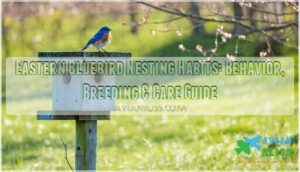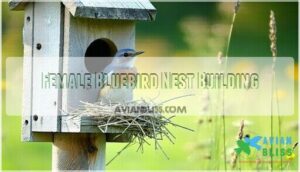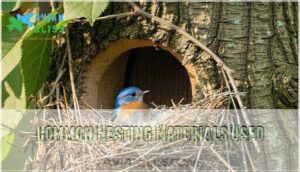This site is supported by our readers. We may earn a commission, at no cost to you, if you purchase through links.

Eastern bluebird nesting habits revolve around cavity selection, a behavioral adaptation that distinguishes them from open-cup nesters and makes them entirely dependent on finding or being provided with suitable holes. Research shows that bluebirds selecting boxes with less than 5% shrub cover within an 11-meter radius achieve notably higher fledging success, demonstrating how precise their site requirements are.
Understanding these nesting patterns—from courtship displays to nestling care—reveals how you can support these birds through strategic habitat management and nest box placement.
Table Of Contents
- Key Takeaways
- Eastern Bluebird Nesting Habits Explained
- Natural and Artificial Nest Sites
- Nest Construction and Materials
- Breeding and Mating Rituals
- Egg Laying and Incubation
- Raising and Caring for Nestlings
- Bluebird Nest Box Placement Tips
- Diet and Foraging During Nesting
- Conservation and Nesting Success
- How to Support Bluebird Nesting
- Frequently Asked Questions (FAQs)
- What month do bluebirds lay their eggs?
- Do bluebirds come back to the same nest every year?
- How long do baby bluebirds stay in the nest?
- What is the behavior of a bluebird nesting?
- Do Eastern Bluebirds nest in the same location every year?
- What is the average lifespan of an Eastern Bluebird?
- How do Eastern Bluebirds protect their nests from predators?
- Can Eastern Bluebirds be attracted to urban backyards and gardens?
- Can bluebirds reuse old nests from previous years?
- How do bluebirds defend against nest competitors?
- Conclusion
Key Takeaways
- Eastern Bluebirds depend entirely on finding pre-existing cavities for nesting, with research showing that boxes positioned in areas with less than 5% shrub cover within 11 meters achieve significantly higher fledging success than sites with denser vegetation.
- Female bluebirds construct nests over 4-5 days using layered materials (coarse grasses for foundation, finer materials for the cup, soft elements for lining), sometimes building multiple test nests before selecting the final site based on predator exposure and microclimate conditions.
- Nestlings fledge between 16-21 days after hatching but remain dependent on parents for approximately three additional weeks while learning essential foraging and flight skills, making nearby cover critical for post-fledging survival.
- Nest box placement between 15-30 meters from scattered trees, at least 35 meters from forest edges, and in areas with minimum 28% grassland within 200 meters directly impacts reproductive success by balancing foraging access against competition from house wrens and predation risks.
Eastern Bluebird Nesting Habits Explained
Eastern Bluebird nesting habits reveal fascinating insights into cavity-nesting behavior and reproductive strategies. Understanding how these birds select sites, construct nests, and time their breeding cycles helps you support their populations effectively.
We’ll explore the essentials of their nesting behavior—how they choose sites, the seasonal patterns that shape breeding success, and what drives their reproductive timing.
Overview of Nesting Behavior
When you watch an Eastern Bluebird scout a hollow tree limb or inspect a weathered fence post, you’re witnessing a cavity-nesting specialist that depends entirely on pre-existing holes for its reproductive success. Unlike birds that build nests from scratch, Eastern Bluebird nesting behavior revolves around finding ready-made cavities—whether natural tree hollows or nest boxes—where bluebird pairs can safely raise their young through multiple breeding cycles each season.
Success comes down to two essentials: finding the right cavity and gathering enough nesting material.
Importance of Nest Site Selection
You’ll discover that nest box placement dramatically shapes Eastern Bluebird nesting success—choosing the wrong spot can turn a helpful structure into an ecological trap. Site selection matters because habitat quality determines survival: research shows bluebirds prefer boxes with minimal surrounding vegetation, positioned strategically to avoid competition and predation.
Here’s what the research tells us about choosing the right spot:
- Place nest boxes over 35 meters from forest edges to minimize house wren competition
- Secure less than 5% shrub cover within an 11-meter radius
- Position boxes 15–30 meters from scattered trees or shrubs for ideal foraging access
- Maintain at least 28% grassland within a 200-meter radius for hunting insects
These placement principles don’t just attract bluebirds—they protect fledglings during their vulnerable first weeks outside the nest, when nearby cover becomes critical for survival. Effective nest box management requires understanding nest box studies to create a favorable environment.
Seasonal Nesting Patterns
Understanding where and when to place nest boxes becomes even more valuable once you recognize that Eastern Bluebirds follow predictable breeding schedules tied directly to temperature, daylight, and food availability throughout the year. Most populations initiate nesting cycles between March and July, with southern residents beginning earlier than northern counterparts.
Climate adaptation influences migration patterns—warmer-region birds remain year-round, while northern populations migrate, returning when insects emerge. You’ll notice habitat selection shifts seasonally as breeding seasons progress, making properly positioned nesting boxes critical during peak reproductive windows.
Natural and Artificial Nest Sites
Eastern Bluebirds show clear preferences when choosing where to raise their young, whether in natural tree cavities or human-made nest boxes. Understanding these site options helps you create ideal conditions for nesting success.
The specific cavity types and placement factors play a major role in where these vibrant birds establish their breeding territories.
Preferred Natural Cavities
In the wild, Eastern Bluebirds (Sialia sialis) naturally seek out abandoned woodpecker cavities in dead pine or oak trees, taking advantage of these ready-made shelters rather than excavating their own. As secondary cavity nesters, they’re opportunistic homemakers, scanning their open woodland territories for suitable sites. You’ll find them investigating:
- Tree Cavities – Old woodpecker holes in dead or dying pines and oaks
- Hollow Logs – Decaying timber with accessible openings
- Rock Crevices – Natural splits in rocky outcrops
- Fence Posts – Weathered wooden posts with decay-formed hollows
These natural nesting spots offer protection from predators and weather while keeping their brood secure.
Use of Nest Boxes
Since natural cavities aren’t always available, you can help Eastern Bluebirds by installing nest boxes—and older, experienced birds often prefer them over wild sites, especially when the entrance hole is sized just right.
Well-designed nestboxes with 1.5-inch entrance holes and predator guards offer snugger, safer quarters than most natural cavities.
You’ll find that proper box installation in open areas with adequate maintenance creates ideal nesting conditions, making your backyard a haven for these vibrant thrushes throughout breeding season.
Factors Affecting Site Choice
When you’re choosing where to place nest boxes for Eastern Bluebirds, vegetation density matters most—they’ll occupy boxes in open, sunny spots with minimal shrub cover 60.8% of the time. Keep boxes at least 35 meters from forest edges and over 200 meters from water to reduce predation risks.
Climate effects also play a role; temperatures consistently above 42°C decrease nest box selection. Urban noise and proximity to roads lower occupancy by 25%, so aim for quiet, open bird habitats away from disturbance.
To further protect the birds, understanding bluebird predator behaviors is essential for effective conservation strategies.
Nest Construction and Materials
Female Eastern Bluebirds handle all the nest-building themselves—a task that showcases how inventive and flexible these birds really are.
What they pick and how they build reveals a lot about their nesting success and survival instincts.
Once you spot these building patterns, you’ll know exactly what to provide when bluebirds show up looking for a home.
Female Bluebird Nest Building
When you watch a female Eastern Bluebird begin her nest construction, you’re witnessing an architectural feat that takes about four to five days of focused, deliberate work. Her female instinct drives precise Bluebird behavior throughout the nesting cycle. She approaches nest architecture systematically:
- Foundation layer: Coarse grasses form the structural base within natural cavities or nesting boxes
- Interior weaving: Finer materials create a cup-shaped chamber optimizing nesting success
- Lining completion: Soft elements provide thermal regulation for Eastern Bluebird eggs
This bird nesting habit demonstrates how Bluebird nesting behavior enhances reproductive outcomes through methodical nesting techniques.
Common Nesting Materials Used
You’ll find Eastern Bluebirds surprisingly resourceful regarding gathering nesting materials, selecting everything from wispy pine needles to the coarse strands of horse hair with exceptional precision. Material selection reflects regional availability and nest insulation requirements within tree cavity sites or nestbox installations.
Understanding bird nesting habits helps you support Eastern Bluebird nesting behavior through appropriate habitat management.
| Material Category | Examples | Primary Function |
|---|---|---|
| Structural Base | Dry grasses, weed stems | Foundation stability in nesting platforms |
| Intermediate Layer | Pine needles, small twigs | Thermal regulation and nest box design compatibility |
| Soft Lining | Horse hair, turkey feathers, fine grasses | Insulation for eggs and cushioning |
Multiple Nest Construction Behavior
Female Eastern Bluebirds don’t put all their eggs in one basket—literally—as they’re known to construct multiple nests within their territory before selecting the final site for egg laying. This nest architecture strategy allows female choice to determine ideal placement, considering predator exposure and microclimatic conditions. Such nesting strategies among cavity nesters demonstrate intricate bluebird pairing dynamics, where males defend territories while females assess nesting boxes and natural cavities. Nest reuse patterns remain uncommon between seasons.
Consider these fascinating bluebird nesting habits:
- Your nestbox might be one of several "test runs" before an Eastern Bluebird commits to raising her family there
- She’s not being indecisive—she’s being protective, carefully weighing safety and comfort for her future nestlings
- Each abandoned nest tells a story of maternal instinct, showing how deeply these cavity nesters care about giving their young the best possible start
Breeding and Mating Rituals
Eastern Bluebirds don’t just pair up and start nesting—they follow distinct courtship rituals that strengthen bonds and establish breeding partnerships. The male takes the lead in courtship displays, while both birds engage in behaviors that cement their connection before eggs appear.
These three behaviors show how bluebirds lay the groundwork for a successful breeding season.
Courtship Displays and Songs
If you’ve ever watched a male Eastern Bluebird in spring, you know he’s not shy about putting on a show. His courtship display involves fluttering his wings, puffing his bright plumage, and delivering soft warbling songs that seem designed to win over even the pickiest female.
These vocal displays aren’t just for show; they’re critical for mate selection, signaling health and territory quality. The male’s avian behavior combines visual and auditory cues, creating a compelling case for pair bonding that resonates across bird habitats.
Pair Bonding Behaviors
Once the courtship show wraps up, pair bonding kicks into higher gear through subtle but telling behaviors you might miss if you’re not watching closely.
You’ll spot pairs perched side by side, gently preening each other’s feathers—a social bonding ritual that reinforces mate selection and strengthens monogamy patterns.
These courtship rituals demonstrate the Eastern Bluebird’s commitment to pair formation, essential for successful nesting and breeding in their chosen bird habitats.
Differences Between Male and Female Roles
While the pair bond looks harmonious from the outside, male and female Eastern Bluebirds actually divide their labor with surprising precision once nesting begins. Male dominance is evident in territory defense and provisioning, while female care focuses on nest construction and incubation—classic sex differences in avian behavior.
Parental investment strategies rarely show role reversal during bird breeding, with each sex contributing to nesting and breeding success through distinct, complementary behaviors.
Egg Laying and Incubation
After the pair bonds, the female will start preparing to lay eggs in the nest they’ve built together.
What happens next depends on a mix of instinct and environmental cues. The timing of egg-laying, what the eggs look like, and how incubation unfolds all follow natural rhythms that vary by species and conditions.
Timing of Egg Laying
Eastern Bluebirds usually begin laying eggs in early spring, with timing carefully synchronized to regional climate patterns and the abundance of insect prey needed to nourish their developing young. In northern populations, egg laying cycles start in late March or April, while southern birds may begin as early as February.
Breeding seasons vary considerably across their range:
- First clutches usually appear 7-14 days after nest completion
- Peak nesting schedules align with maximum caterpillar availability
- Multiple broods per season extend egg laying through July
- Incubation periods average 13-16 days, with fledging times of 16-21 days
Understanding Eastern Bluebird biology and these nesting habits helps you support successful breeding in your area.
Clutch Size and Egg Appearance
Most clutches contain 4–5 eggs, though you might observe anywhere from 2 to 7 eggs per nest depending on location and timing. Breeding Season Patterns reveal that northern populations often produce larger clutches, while late-season nests average about 0.7 fewer eggs.
Eastern Bluebird eggs usually measure 0.7–0.9 inches long with a characteristic pale blue shade—lighter and less glossy than robin eggs.
Egg Color Variations occur rarely: roughly 2% are white, and less than 1% appear pink or off-white, yet these variations don’t affect Nesting Success Rates or the incubation period ahead.
Incubation Duties and Period
You’ll watch the female shoulder nearly all the incubation work, sitting tight on her clutch for about 12–14 days while the male delivers food and keeps watch nearby. She’ll turn each Bluebird egg regularly to maintain even nest temperature—essential for brood survival.
Eastern Bluebird incubation periods rarely exceed two weeks, and her dedicated female care ensures cavity nesters like these thrive from egg laying through hatching.
Raising and Caring for Nestlings
When the eggs finally hatch, both parents kick into high gear—their days suddenly consumed with feeding and protecting their vulnerable young.
The nestling stage is when things get intense—chicks grow at breakneck speed, and parents are on duty around the clock.
Watch them during these early weeks and you’ll see just how much effort goes into raising a clutch—it’s exhausting work that never lets up.
Nestling Growth Stages
From the moment hatchlings emerge—naked, eyes sealed shut, weighing barely 2.8 grams—nestling development unfolds in a predictable yet striking arc. You’ll notice their skin darkening to blue-black by day two as feather growth begins beneath the surface.
Eyes open around days five to seven, while thermoregulation kicks in by day eight. Growth rates surge at 0.35 grams per hour under ideal conditions, pushing nestlings toward their fledging patterns between days 16 and 22, with most young departing around day 19—though spring broods tend to linger slightly longer than summer ones.
Parental Feeding and Protection
Both parents dive into feeding duty with relentless precision, delivering insect meals to gaping mouths every few minutes from dawn until dusk. Feeding behavior intensifies as nestlings grow—caterpillars and beetles dominate the diet, fueling rapid development.
Nest defense becomes fierce when predators approach; adults mob intruders with alarm calls and diving attacks. This parental investment ensures chick protection through coordinated avian behavior, with both sexes equally committed to fledgling care.
How Long Nestlings Stay in The Nest
Nestlings usually fledge between 16 and 21 days after hatching, though weather conditions and food availability can shift this timeline by several days. You’ll notice fledglings perch near the nest entrance, exercising wings before departure.
Once they leave, brood care continues—parents feed fledglings for roughly three weeks while teaching essential foraging skills. This extended parental investment in nestling development ensures Eastern Bluebirds master flight and hunting before independence, a critical phase in avian nesting behavior.
Bluebird Nest Box Placement Tips
Setting up a nest box correctly can make the difference between a thriving bluebird family and an empty box. Your placement choices directly affect whether bluebirds will claim the space and successfully raise their young.
We’ll cover where to position your nest box, proper installation techniques, and the maintenance that keeps it welcoming year after year.
Ideal Locations for Nest Boxes
If you want bluebirds to claim your nest box as their own, location matters more than you might think—choosing the right spot can mean the difference between an empty box and a thriving family.
Eastern Bluebirds, as cavity nesters adapted to open country, thrive when you place nestboxes strategically:
- Open Field placement with short grass for visible foraging
- Fence Line positioning in rural areas facing away from prevailing winds
- Tree Proximity of 25-100 feet (not closer)
- Nest Box Orientation facing east or southeast
- Clear flight paths with minimal obstructions
These bird breeding habits demand open sight lines for hunting insects while maintaining a safe distance from dense cover where predators lurk.
Installation Guidelines
Once you’ve picked the perfect spot, getting that nest box properly installed takes more than just hammering it onto a post—the height, angle, and mounting method all play essential roles in whether bluebirds will settle in safely.
You’ll want to mount your nest box 4-6 feet high on a smooth metal pole with predator guards below, ensuring the entrance hole tilts slightly forward for drainage while maintaining secondary cavity-nesting standards that support bird conservation techniques.
| Installation Parameter | Specification |
|---|---|
| Mounting Heights | 4-6 feet above ground |
| Entrance Hole Tilt | 5-10° forward lean |
| Predator Guards | Conical baffle 2 feet below box |
Proper nest box placement with these wildlife management principles protects against climbing predators and weather while making artificial nest boxes accessible for box maintenance.
Nest Box Maintenance and Cleaning
After installing your box correctly, keeping it clean between broods isn’t just good practice—it’s what separates a one-time nest from a bluebird favorite that gets reused season after season. You’ll support bird conservation techniques and secondary cavity-nesting success by following these maintenance tips:
- Remove old nesting materials after fledging using proper nest box sanitation protocols
- Inspect predator guards and nestbox hardware monthly during breeding season
- Replace damaged artificial nest boxes to maintain bluebird housing standards
Consistent cleaning schedules between broods prevent parasites while keeping your boxes attractive to returning pairs.
Diet and Foraging During Nesting
When you’re supporting nesting bluebirds, understanding their dietary needs becomes just as important as providing the right nest box.
What bluebirds eat changes throughout the breeding season—they adapt based on what’s available and what their growing chicks need most. Here’s how these birds feed themselves and their nestlings during this crucial period.
Main Food Sources for Bluebirds
For much of the year, you’ll find Eastern Bluebirds hunting insects on the ground—caterpillars, beetles, crickets, grasshoppers, and spiders make up the bulk of their diet. These insect prey provide essential protein, especially during nesting when adults feed mealworms and other invertebrates to growing nestlings.
You’ll also notice them consuming fruit sources like mistletoe berries and sumac when available, plus they occasionally take small vertebrates—salamanders, shrews, even tiny lizards—demonstrating remarkably diverse wildlife diet and nutrition needs.
Seasonal Diet Variations
As temperatures shift through the calendar, so does the Eastern Bluebird’s menu. Insects dominate spring and summer feeding, while fall and winter bring a dramatic pivot toward fruits like mistletoe, sumac, and blueberries.
You’ll notice insect abundance peaks during breeding season when mealworms and caterpillars fuel nestling growth, providing critical nutrient intake.
Winter foraging shifts to berry selection as these fruits sustain adults through harsh months when invertebrate prey becomes scarce—this seasonal ecology pattern reflects outstanding dietary flexibility in wildlife diet and nutrition strategies.
Feeding Young and Foraging Strategies
When those nestlings hatch, both parents kick into high gear, ferrying protein-packed insects back to the nest box with impressive frequency. You’ll observe intricate foraging techniques as adults perch low, then drop groundward for insect capture—caterpillars, beetles, and spiders dominate the nestling diet.
Parental foraging intensifies hourly, with no food storage behavior; fresh prey delivery ensures excellent nutrition throughout bird breeding season, showcasing impressive avian behavior and ecology.
Conservation and Nesting Success
Eastern Bluebird populations have faced real challenges over the past century, but their story is one of extraordinary recovery.
The trends, threats, and programs that sparked this turnaround tell a compelling story.
Once you know what helps bluebirds nest successfully—and what gets in their way—you can create real change right in your own yard.
Population Trends and Recovery
Eastern Bluebird populations showcase a striking conservation success story, rebounding from severe declines through targeted recovery efforts. Since 1966, populations have grown approximately 2.4% annually, with breeding numbers now estimated between 20 and 23 million individuals.
Key factors driving this demographic turnaround include:
- Installation of thousands of nest boxes across North America
- Habitat restoration through prescribed burns reversing fire suppression impacts
- Reintroduction programs in extirpated areas like Everglades National Park
- Continuous monitoring through ornithological research and breeding bird surveys
This species conservation achievement demonstrates how community-driven wildlife conservation initiatives can reverse population declines effectively.
Threats to Nesting Bluebirds
Despite their recovery, Eastern Bluebirds face multiple threats during nesting season. Nest predation from house wrens, house sparrows, and raccoons remains persistent, with orchard sites showing double the depredation rates.
Nest parasites like brown-headed cowbirds and Protocalliphora flies weaken nestlings through reduced hemoglobin and delayed fledging.
Climate change shifts breeding phenology, while habitat loss from development eliminates essential open grasslands these cavity nesters need for successful bird nesting and wildlife conservation efforts.
Effective Conservation Programs
Through strategic habitat restoration and species recovery initiatives, you can witness conservation strategies that work. Nest box management programs have documented over 30,000 native birds fledged across 60 years of wildlife preservation efforts.
Tennessee’s 2020 wildlife conservation efforts fledged 3,435 bluebirds from 1,053 monitored boxes—averaging 4.27 per box.
These bird conservation programs demonstrate how habitat preservation and restoration, combined with volunteer monitoring and data-driven adjustments, successfully advance conservation of bird species.
How to Support Bluebird Nesting
Supporting nesting bluebirds isn’t complicated, but it does require thoughtful preparation. You’ll want to create the right conditions in your yard, keep an eye on active nests without interfering, and guard against common threats.
Focus on these key areas to help bluebirds successfully raise their young.
Creating a Bluebird-Friendly Habitat
You don’t need a sprawling estate to roll out the welcome mat for Eastern Bluebirds—just a few thoughtful touches can transform your yard into prime nesting territory. Start with native plantings that support insect populations—the backbone of their diet—while leaving open zones with short grass for foraging.
Water sources like shallow birdbaths help, especially during breeding season. Thoughtful landscape design balancing bird-friendly zones with visibility aids habitat preservation, supporting broader avian ecology and conservation efforts.
Monitoring and Protecting Nests
Keeping watch over your bluebird nest boxes isn’t just helpful—it’s essential for boosting nesting success and catching problems before they spiral out of control. Weekly checks let you track nesting success rates, spot nest predator control needs, and manage nestbox maintenance without disturbing fledglings.
Bluebird nest cameras offer real-time monitoring while supporting bird conservation and wildlife habitat protection strategies for Eastern Bluebirds.
Avoiding Disturbance and Predators
Protecting bluebird nests from threats requires a delicate balance—too much human interference can cause abandonment, while too little leaves families vulnerable to predators and environmental hazards. Install predator guards on nest box poles to improve habitat security and bird safety for secondary cavity-nesting species.
Limit checks to once weekly during bird breeding season, respecting avian behavior and ecology while supporting wildlife conservation. Strategic nest camouflage through thoughtful placement strengthens predator avoidance and threat management for Eastern Bluebirds.
Frequently Asked Questions (FAQs)
What month do bluebirds lay their eggs?
Bluebird eggs usually appear in late March through early April across most of their range, though breeding cycles vary with latitude.
Eastern Bluebirds in warmer southern regions often begin egg-laying patterns earlier, while northern populations delay until consistent food supplies emerge.
Do bluebirds come back to the same nest every year?
Here’s the thing: bluebirds don’t put all their eggs in one basket regarding nest reuse. Eastern Bluebirds usually return to the same general territory annually, but they’ll build fresh nests rather than reusing old ones, especially in nestboxes where fledglings left behind parasites.
How long do baby bluebirds stay in the nest?
Baby bluebirds usually remain in the nest for 15 to 20 days after hatching.
Fledglings leave when they’ve developed sufficient flight feathers, though they’ll still depend on their parents for food and protection for several weeks post-departure.
What is the behavior of a bluebird nesting?
Nesting Instincts drive Bluebird Pairs through multiple Nesting Cycles annually. During each brood, females construct cup-shaped nests in Secondary Cavity-Nesting sites—like Nestboxes—then incubate Bluebird eggs while males defend territories.
Both parents share Fledgling Care duties, demonstrating cooperative Brood Behavior essential for successful bird habitats and behavior.
Do Eastern Bluebirds nest in the same location every year?
Site fidelity varies—some Eastern Bluebirds return to previous breeding territories and reuse nest boxes, while others explore new habitats.
Annual migration patterns and nestbox availability influence their habitat loyalty more than strict attachment to one nesting site.
What is the average lifespan of an Eastern Bluebird?
In the wild, these vibrant thrushes (Sialia sialis) usually survive six to eight years, though some individuals exceed a decade.
Mortality rates vary considerably based on predation pressure, habitat quality, and seasonal weather extremes affecting survival.
How do Eastern Bluebirds protect their nests from predators?
Survival hinges on vigilance—parent bluebirds aggressively mob predators approaching their nests, diving and vocalizing to drive threats away. You’ll observe nest guarding behavior where adults patrol cavities constantly.
Secondary cavity-nesting bird species like Eastern Bluebirds rely on strategic site selection and brood defense rather than nest camouflage, making predator deterrents and egg protection through active wildlife management essential for ornithological research on nesting success.
Can Eastern Bluebirds be attracted to urban backyards and gardens?
Yes, you can attract them to urban gardens by offering open lawn areas with short grass for foraging, installing properly placed nest boxes, providing fresh water sources, and maintaining native plants that support insects—their primary food during breeding season.
Can bluebirds reuse old nests from previous years?
Like birds returning to familiar ground, bluebirds don’t usually reuse old nests. Instead, you’ll want to remove old nesting materials between breeding seasons—nest sanitation prevents parasite buildup and disease transmission.
Fresh nest construction fosters healthier broods and improved nest reuse benefits for secondary cavity-nesting species through proper wildlife ecology and habitat management practices.
How do bluebirds defend against nest competitors?
Male bluebirds aggressively chase intruders from cavity sites using vocalizations and physical confrontation. They’ll employ territorial marking through song perches.
Females may defend by staying inside the nest box, deterring house sparrows and other secondary cavity-nesting competitors.
Conclusion
Picture a sun-warmed meadow edge where freshly fledged bluebirds test their wings—the culmination of precise cavity selection, vigilant parental care, and your thoughtful habitat management. Understanding eastern bluebird nesting habits transforms you from observer to steward.
By positioning nest boxes in open areas with minimal shrub cover, monitoring clutches without disturbance, and maintaining clean cavities between broods, you create conditions where territorial males sing confidently and females raise multiple successful clutches.
Your informed actions don’t just support individual pairs—they sustain population recovery across entire landscapes.














